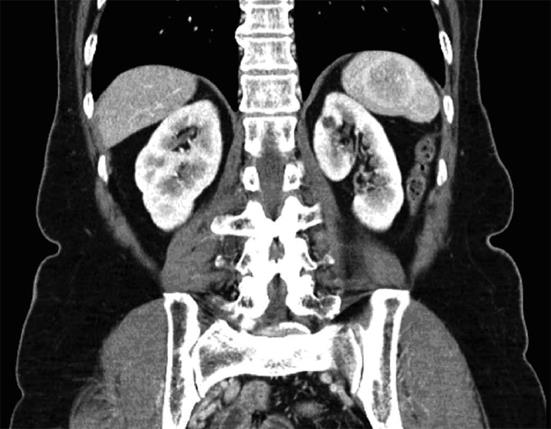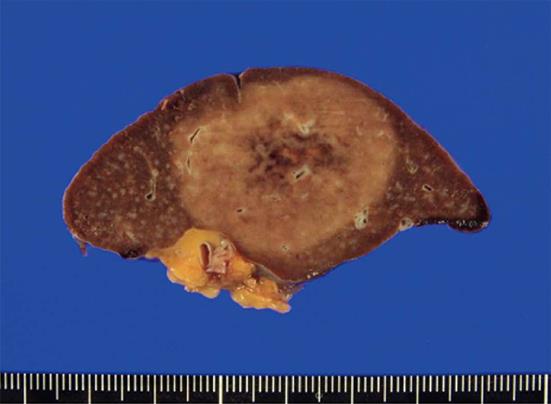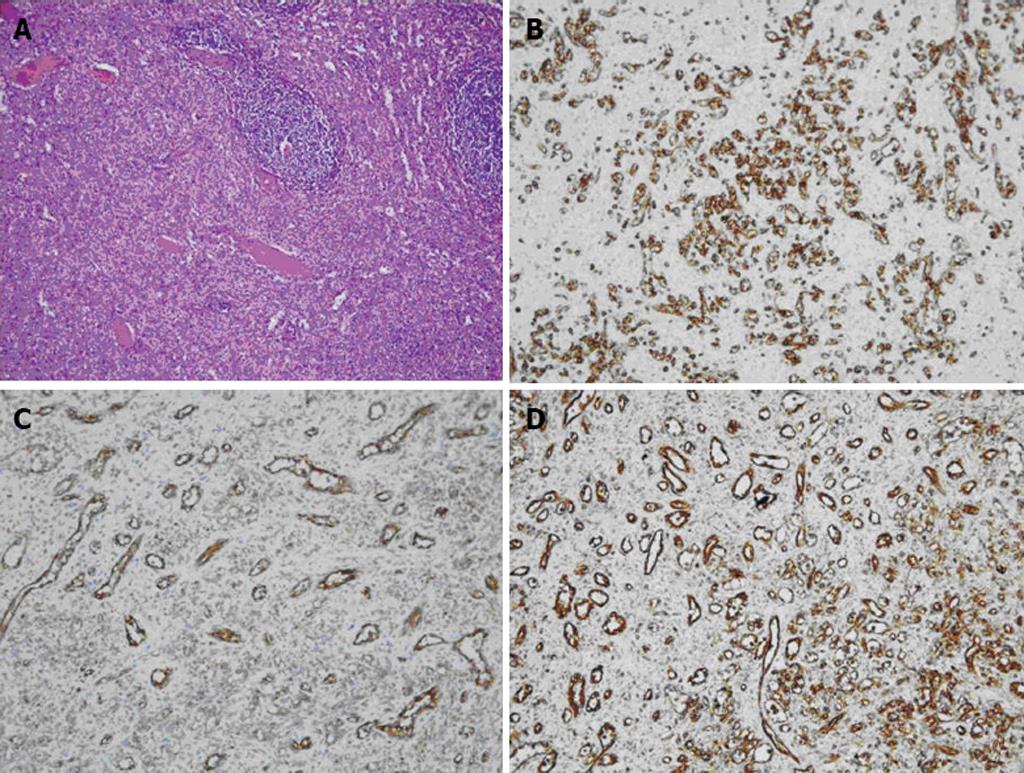Published online Oct 16, 2013. doi: 10.12998/wjcc.v1.i7.217
Revised: August 8, 2013
Accepted: August 20, 2013
Published online: October 16, 2013
Processing time: 95 Days and 12.1 Hours
Splenic hamartoma is a rare benign malformation, composed of an anomalous mixture of normal splenic elements, often found incidentally while working up other complaints or at autopsy. A splenic mass was incidentally found while evaluating the effects of a traffic accident in a 63-year-old woman. Abdominal computed tomography revealed a well-defined splenic mass with rim enhancement. The patient underwent splenectomy. The resected spleen contained a well-defined mass lesion measuring 3.5 cm × 3.0 cm. Microscopic examination revealed disorganized slit-like vascular channels lined by plump endothelial cells without atypia. The cells lining the vascular channels were positive for CD8, CD31, CD34 and vimentin. Endothelial cells that are positive for CD8 are a key feature that differentiates hamartoma from other vascular lesions of the spleen. Although this tumor is very rare, it must be included in the differential diagnosis of splenic mass-forming lesions.
Core tip: It is important to consider that splenic hamartoma is included in the differential diagnosis of splenic mass-like lesions, although it is a benign and very rare.
- Citation: Sim J, Ahn HI, Han H, Jun YJ, Rehman A, Jang SM, Jang K, Paik SS. Splenic hamartoma: A case report and review of the literature. World J Clin Cases 2013; 1(7): 217-219
- URL: https://www.wjgnet.com/2307-8960/full/v1/i7/217.htm
- DOI: https://dx.doi.org/10.12998/wjcc.v1.i7.217
Splenic hamartoma is a rare benign vascular proliferative neoplasm characterized by CD8 immunopositivity of the vascular endothelial lining cells[1]. It is composed of an anomalous mixture of normal splenic elements, such as red and white pulp[2]. Since the first case of splenic hamartoma was described by Rokitansky[3], more than 150 cases have been reported, with an incidence of 0.024% to 0.13% given in a review of autopsies[4]. Most cases are often discovered incidentally at autopsy or when evaluating images for other reasons[1]. Splenic hamartoma has also been called splenoma, accessory spleen in spleen, congenital malformation and hyperplastic nodule[1,5]. Although splenic hamartoma is benign, it is important to differentiate it from splenic malignancies, including metastatic tumors[1,6]. We report a rare case of splenic hamartoma found incidentally while evaluating the effects of a traffic accident in a 63-year-old woman.
A 63-year-old woman visited our hospital for further evaluation of a splenic mass found incidentally during the evaluation of the consequences of a traffic accident. She had a ten year history of diabetes mellitus. Laboratory examinations were unremarkable. On physical examination, there was no palpable mass in the abdomen. Abdominal computed tomography (CT) revealed a homogeneous round mass with rim enhancement in the splenic parenchyma (Figure 1). Radiologically, the possibility of a metastatic cancer of unknown origin or splenic hemangioma was suspected. However, there was no evidence of primary malignancy on gastroscopy, colonoscopy, abdominal ultrasonography and positron emission tomography (PET)-CT. PET-CT findings suggested a benign splenic tumor. The patient underwent a laparoscopy-assisted splenectomy.
The resected spleen measured 8 cm × 5 cm and the outer surface was unremarkable. The cut surface revealed a well-defined homogeneous red-tan mass of 3.5 cm × 3.0 cm. The mass was a round, well-circumscribed, unencapsulated bulging nodule compressing the adjacent normal splenic parenchyma (Figure 2). There was no evidence of hemorrhage or necrosis. Microscopically, the vague nodular tumor contained haphazardly arranged small slit-like vascular spaces enclosing red blood cells. The vascular spaces were lined with plump endothelial cells without atypia and the intravascular areas enclosed focal lymphoid aggregates with a connecting network of fibrosis. The tumor was well demarcated from the adjacent normal spleen and the surrounding normal parenchyma was focally compressed. There was no fibrous capsule and the histology of the surrounding spleen was unremarkable, consisting of red and white pulp. Immunohistochemically, the lining endothelial cells of the vascular channels were positive for CD8, CD31, CD34 and vimentin (Figure 3). The scattered stromal macrophages were CD68-positive, whereas the cells lining the vascular spaces were CD68-negative. The final pathological diagnosis was a splenic hamartoma. After the operation, the 7 mo follow-up period was uneventful.
In this report, we describe a rare and interesting case of splenic hamartoma, which was found incidentally during the evaluation of a traffic accident. More than 80% of such cases are asymptomatic and found incidentally at autopsy or during image evaluation for other reasons[5]. Approximately 20% of the cases present with primary or systemic symptoms. The common presenting clinical manifestations are splenomegaly, palpable mass, spontaneous rupture, anemia, thrombocytopenia and digestive symptoms, including loss of appetite and abdominal pain[1,7]. A strong association between splenic hamartomas and solid and hematological malignancies, including thymomas, squamous cell carcinomas and renal cell carcinomas, has been reported and rare cases of splenic hamartoma also occur, associated with tuberous sclerosis[1,5].
Recently, Wang et al[7] described the radiological features of splenic hamartomas on ultrasonography (US), color Doppler imaging, CT and magnetic resonance imaging (MRI). Most are hyperechoic solid masses relative to the adjacent normal splenic parenchyma on US. On color Doppler imaging, there is evidence of increased blood flow resulting from hypervascularity. On CT imaging, the hamartomas appear as isodense or hypodense solid masses relative to the adjacent normal splenic parenchyma. Cystic changes and combined calcification are regarded as the characteristic CT findings. MRI findings differ depending on whether the tumor is fibrous or non-fibrous. Most splenic hamartomas are isointense in T1-weighted MRI and heterogeneously hyperintense in T2-weighted MRI.
According to the review literature[1,7], splenic hamartomas present as solitary or multiple lesions forming round, well-circumscribed, unencapsulated bulging nodules compressing the adjacent normal splenic parenchyma. The tumors vary in size with a median size of 5 cm and a maximum of 20 cm. They are of two histological types: a white pulp type and a red pulp type. The white pulp type is composed of lymphoid tissue and the red pulp type is composed of an aberrant complex of sinuses. Most tumors are a mixture of the two subtypes. The characteristic histological features are disorganized vascular channels lined by plump endothelial cells. The lining cells of the vascular channels are typically positive for CD8, CD31, CD34, factor VIII-related antigen and vimentin[5,8].
The origin of splenic hamartomas is still controversial. Some consider them to be congenital malformations of the splenic red pulp, others to be neoplasms of the splenic red pulp or post-traumatic reactive lesions[2,9]. They have also been seen as acquired proliferative processes, with documented cases associated with hematological malignancy[6]. The main differential diagnosis includes other vascular tumors and solid mass-forming lesions of the spleen. Hemangioma, littoral cell angioma, lymphangioma, hemangioendothelioma, sclerosing angiomatoid nodular transformation and angiosarcoma are included in the pathological differential diagnosis[1]. The radiological differential diagnosis includes inflammatory myofibroblastic tumor, lymphoma and metastatic tumors[7]. Splenectomy is also important in patients with an incidentally discovered mass in the spleen when a malignant tumor cannot be ruled out. Splenic hamartoma with systemic or primary symptoms is rare but often associated with hematological disorders, which can be cured by splenectomy[10].
In conclusion, splenic hamartoma is a benign vascular proliferative lesion with the characteristic CD8 positive immunophenotype of the lining endothelial cells. Although this tumor is very rare, it must be included in the differential diagnosis of splenic mass-forming lesions.
P- Reviewers Chetty R, Lai V S- Editor Gou SX L- Editor Roemmele A E- Editor Wu HL
| 1. | Lee H, Maeda K. Hamartoma of the spleen. Arch Pathol Lab Med. 2009;133:147-151. [RCA] [PubMed] [DOI] [Full Text] [Cited by in RCA: 4] [Reference Citation Analysis (1)] |
| 2. | Silverman ML, LiVolsi VA. Splenic hamartoma. Am J Clin Pathol. 1978;70:224-229. [PubMed] |
| 3. | Tsitouridis I, Michaelides M, Tsitouridis K, Davidis I, Efstratiou I. Symptomatic splenoma (hamartoma) of the spleen: A case report. Hippokratia. 2010;14:54-56. [PubMed] |
| 4. | Lam KY, Yip KH, Peh WC. Splenic vascular lesions: unusual features and a review of the literature. Aust NZJ Surg. 1999;69:422-425. [PubMed] |
| 5. | Ali TZ, Beyer G, Taylor M, Volpe C, Papadimitriou JC. Splenic hamartoma: immunohistochemical and ultrastructural profile of two cases. Int J Surg Pathol. 2005;13:103-111. [RCA] [PubMed] [DOI] [Full Text] [Cited by in Crossref: 14] [Cited by in RCA: 16] [Article Influence: 0.8] [Reference Citation Analysis (1)] |
| 6. | Abbott RM, Levy AD, Aguilera NS, Gorospe L, Thompson WM. From the archives of the AFIP: primary vascular neoplasms of the spleen: radiologic-pathologic correlation. Radiographics. 2004;24:1137-1163. [RCA] [PubMed] [DOI] [Full Text] [Cited by in Crossref: 281] [Cited by in RCA: 240] [Article Influence: 11.4] [Reference Citation Analysis (0)] |
| 7. | Wang JH, Ma XL, Ren FY, Zuo CJ, Tian JM, Wang ZF, Zheng JM. Multi-modality imaging findings of splenic hamartoma: a report of nine cases and review of the literature. Abdom Imaging. 2013;38:154-162. [RCA] [PubMed] [DOI] [Full Text] [Cited by in Crossref: 28] [Cited by in RCA: 31] [Article Influence: 2.6] [Reference Citation Analysis (0)] |
| 8. | Zukerberg LR, Kaynor BL, Silverman ML, Harris NL. Splenic hamartoma and capillary hemangioma are distinct entities: immunohistochemical analysis of CD8 expression by endothelial cells. Hum Pathol. 1991;22:1258-1261. [PubMed] |
| 9. | Sankar S, Thanka J, Jagdishchandrabose S, Rajendran S. Splenic hamartoma: a rare vascular space occupying lesion of the spleen. Indian J Pathol Microbiol. 2011;54:223-225. [RCA] [PubMed] [DOI] [Full Text] [Cited by in Crossref: 6] [Cited by in RCA: 4] [Article Influence: 0.3] [Reference Citation Analysis (0)] |
| 10. | Havlik RJ, Touloukian RJ, Markowitz RI, Buckley P. Partial splenectomy for symptomatic splenic hamartoma. J Pediatr Surg. 1990;25:1273-1275. [PubMed] |















